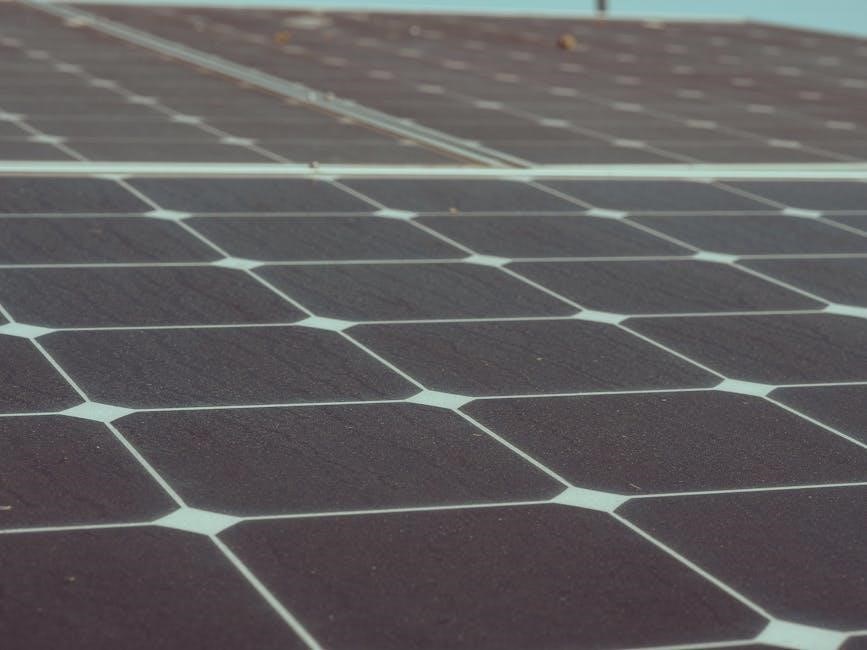Solar panel wiring is the process of connecting photovoltaic (PV) panels to batteries, inverters, and electrical systems. It ensures efficient energy transfer and system safety.
Proper wiring is crucial for maximizing solar energy production and preventing electrical hazards. This guide provides a comprehensive overview of solar wiring principles and best practices.
Understanding solar panel wiring is essential for installing and maintaining renewable energy systems effectively. It involves series, parallel, and hybrid connections to optimize performance and reliability.
By following proper wiring techniques, you can ensure your solar system operates efficiently, safely, and reliably for years to come. Always consult diagrams and guidelines for accuracy.
1.1 What Is Solar Panel Wiring?
Solar panel wiring refers to the process of connecting photovoltaic (PV) panels to create a functional solar energy system. It involves linking panels in series or parallel to achieve desired voltage and current levels. Proper wiring ensures energy flows efficiently from panels to batteries, inverters, and electrical loads. This process requires careful planning to match system requirements and safety standards. Solar wiring diagrams provide visual guidance for connecting components correctly. Accurate wiring is essential for system performance, safety, and reliability, ensuring maximum energy production and minimal electrical risks.
1.2 Importance of Proper Wiring in Solar Systems
Proper wiring is crucial for safety, efficiency, and reliability in solar systems. It prevents electrical hazards like short circuits and fires, ensuring safe operation. Correct connections maintain optimal voltage and current flow, maximizing energy production. Reliable wiring reduces system failures and downtime, while adhering to local codes prevents legal issues. Efficient wiring minimizes repairs and extends system lifespan, saving money. Investing in proper wiring ensures a safe, efficient, and long-lasting solar energy setup.
Types of Solar Panel Wiring Connections
Solar panel wiring connections include series, parallel, and hybrid configurations. Series connections increase voltage, while parallel setups boost current. These configurations optimize energy output and system compatibility.
2.1 Series Wiring: Connecting Solar Panels in Series
Series wiring involves connecting solar panels end-to-end, where the positive terminal of one panel connects to the negative terminal of the next. This configuration increases the total voltage while maintaining the same current. It is ideal for charging batteries or feeding power to inverters that require higher voltage inputs. Series connections are straightforward but require careful planning to ensure compatibility and safety. Proper sizing and alignment are essential to maximize efficiency and prevent energy loss. Always follow diagrams and guidelines for accurate series wiring setups.
2.2 Parallel Wiring: Connecting Solar Panels in Parallel
Parallel wiring connects solar panels by linking their positive terminals together and negative terminals together. This configuration increases the total current while maintaining voltage. It is ideal for systems requiring higher current outputs, such as charging multiple batteries or powering high-current devices. Parallel connections offer flexibility, allowing panels to operate independently, reducing the impact of shading or panel failure. Proper balancing and sizing are crucial to ensure optimal performance and safety. Always refer to wiring diagrams and guidelines for correct parallel setups.

Essential Components of a Solar Panel System
A solar panel system includes solar panels, batteries, inverters, and mounting hardware. These components work together to generate, store, and distribute renewable energy efficiently and safely.
3.1 Solar Panels: Types and Specifications
Solar panels are the core of any solar energy system, converting sunlight into electricity. They come in types like monocrystalline, polycrystalline, and thin-film, each with unique efficiency and cost profiles.
Specifications include power rating (watts), voltage, and efficiency percentage. Higher efficiency panels generate more energy in limited space, while lower-cost options may require more area.
Understanding panel types and specs is crucial for selecting the right modules for your system, ensuring optimal performance and energy production based on your needs and installation constraints.
3.2 Batteries: Role and Sizing in Solar Systems
Batteries play a critical role in solar systems by storing excess energy generated during the day for use at night or during power outages. They ensure a continuous energy supply, making solar systems reliable and practical.
The sizing of batteries depends on factors like load calculation, backup time requirements, and system voltage. Proper sizing ensures the battery can store enough energy to meet demand without overcharging or underperforming.
Deep-cycle batteries, such as lead-acid or lithium-ion, are commonly used in solar systems due to their durability and ability to handle frequent charge/discharge cycles. Correct installation and maintenance are essential for maximizing battery lifespan and system efficiency.
Solar Inverter and Charge Controller
The solar inverter converts DC power from panels to AC for household use, while the charge controller regulates energy flow to batteries, preventing overcharging and ensuring system safety.
Both components are essential for optimizing energy efficiency and protecting the solar system from voltage fluctuations and electrical hazards, ensuring reliable performance and longevity of the setup.
4.1 Understanding Solar Inverters and Their Types
A solar inverter converts DC power from solar panels into usable AC electricity for homes and businesses. It is a critical component for grid-tied and off-grid systems, ensuring compatibility with household appliances.
There are several types of inverters, including string inverters, microinverters, and hybrid inverters. String inverters connect multiple panels, while microinverters optimize individual panel performance. Hybrid inverters integrate battery storage capabilities.
Choosing the right inverter depends on system size, energy needs, and desired functionality. Proper installation and configuration are essential for efficiency, safety, and reliable energy production.
4.2 Charge Controllers: Functions and Installation
A charge controller regulates energy flow between solar panels, batteries, and inverters, preventing overcharging and ensuring efficient energy transfer. It protects the battery from excessive voltage and optimizes charging.
There are two main types: MPPT (Maximum Power Point Tracking) and PWM (Pulse Width Modulation). MPPT controllers maximize energy harvest, while PWM controllers are simpler and cost-effective.
Installation involves connecting solar panels to the controller’s input, batteries to the output, and configuring settings like voltage and charging thresholds. Proper installation ensures system safety and efficiency.
Step-by-Step Solar Panel Installation Guide
A step-by-step solar panel installation guide includes planning, mounting panels, wiring connections, and configuring inverters to ensure a safe and efficient solar energy system setup.
5.1 Planning the System: Load Calculation and Design
Planning a solar system begins with load calculation to determine energy needs. Assessing appliance power requirements and usage patterns ensures proper system sizing. Design involves selecting components like panels, inverters, and batteries, based on energy demand and available space. A well-designed system maximizes efficiency and reliability. Using wiring diagrams and installation guides helps ensure compliance with safety standards and optimal performance. Proper planning is key to a successful solar energy setup.
5.2 Mounting Solar Panels: Fixing and Alignment
Mounting solar panels involves securing them to a surface, such as a roof or ground rack, using durable hardware. Proper alignment ensures maximum sunlight exposure, typically facing south for optimal energy capture. Panels must be fixed at the correct angle to match the location’s latitude for efficiency. Using tools like drills and levels, installers ensure stability and precision. Secure fastening prevents damage from weather conditions. Proper mounting is critical for system performance and longevity, requiring careful planning and execution.

Electrical Wiring for Solar Panels
Electrical wiring connects solar panels to charge controllers, batteries, and inverters, ensuring energy flows efficiently and safely. Proper connections are crucial for optimal system performance and reliability.
6.1 Connecting Solar Panels to the Charge Controller
Connect solar panels to the charge controller by linking the positive wire to the controller’s positive terminal and the negative wire to the negative terminal. Ensure proper polarity to avoid damage. Use a wiring diagram to guide connections. Set the controller’s settings for voltage and charging modes. Turn off the system before connecting to prevent electrical surges. Securely fasten wires to avoid loose connections. Test voltage and current output to confirm proper functionality. Proper connections ensure efficient energy transfer and system safety. Always use high-quality materials to prevent future issues. Follow manufacturer instructions for specific configurations. Ensure all connections are tight and insulated. Regularly inspect wires for wear or damage. This step is critical for optimal system performance and longevity. Grounding the system correctly enhances safety and reliability. Keep all wiring organized to simplify future maintenance. Proper connections prevent energy loss and ensure consistent power supply; Always refer to the wiring diagram for accuracy. Verify that all terminals are securely tightened. Use appropriate wire gauges to handle current loads. Avoid overloading the charge controller capacity. Monitor connections for signs of overheating or corrosion. Ensure compliance with local electrical codes and standards. Proper installation ensures reliable energy harvesting and storage. Regular testing and inspection are essential for long-term system efficiency. This process is fundamental for any solar panel setup, ensuring energy flows safely and efficiently to the battery and inverter. Correct connections prevent system failures and enhance overall performance. Always prioritize safety and precision when wiring solar panels to the charge controller.
6.2 Wiring the Inverter and Battery System
Connect the charge controller’s positive terminal to the battery’s positive terminal and the negative to the negative terminal. Ensure polarity is correct to avoid damage. Next, link the battery’s positive wire to the inverter’s positive input and the negative to the inverter’s negative input. Use appropriate wire gauges to handle the current safely. Secure all connections tightly and insulate them to prevent short circuits. Follow the inverter’s manual for specific wiring requirements. Test the system to ensure proper voltage and current flow. Proper wiring ensures efficient energy conversion and safe operation. Always refer to the wiring diagram for accuracy. Verify that all terminals are securely tightened. Use appropriate wire gauges to handle current loads. Avoid overloading the inverter capacity. Monitor connections for signs of overheating or corrosion. Ensure compliance with local electrical codes and standards. Proper installation ensures reliable energy conversion and storage. Regular testing and inspection are essential for long-term system efficiency. This process is fundamental for any solar panel setup, ensuring energy flows safely and efficiently to the inverter and battery. Correct connections prevent system failures and enhance overall performance. Always prioritize safety and precision when wiring the inverter and battery system.
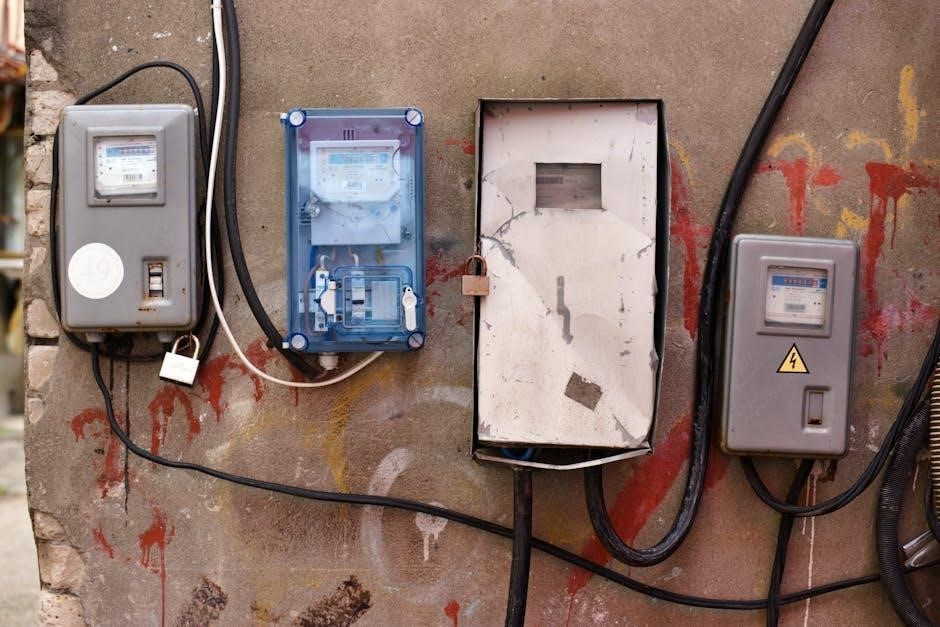
Safety Guidelines for Solar Wiring
Always disconnect power sources before wiring; Ensure correct polarity to avoid short circuits. Use protective gear and follow diagrams. Ground systems properly and adhere to electrical codes.
7.1 Safety Precautions During Installation
Ensure all power sources are disconnected before starting work. Wear protective gear, including gloves and safety glasses. Verify correct polarity to prevent short circuits. Use proper tools and follow wiring diagrams. Keep the area clear of flammable materials. Ensure panels are securely mounted to avoid structural issues. Regularly inspect wiring for damage or wear. Always follow local electrical codes and manufacturer instructions. Grounding systems properly is essential for safety and efficiency.
7.2 Grounding and Earthing in Solar Systems
Grounding and earthing are critical for solar system safety, protecting against electrical faults and voltage buildup. Proper grounding ensures the solar panel system is connected to the earth, preventing hazardous conditions. Earthing equalizes potential differences, safeguarding equipment and users from shock. Install grounding rods and ensure all components are securely connected. Regular inspections are essential to maintain integrity and functionality. Follow local electrical codes and manufacturer guidelines for a safe and reliable solar installation.
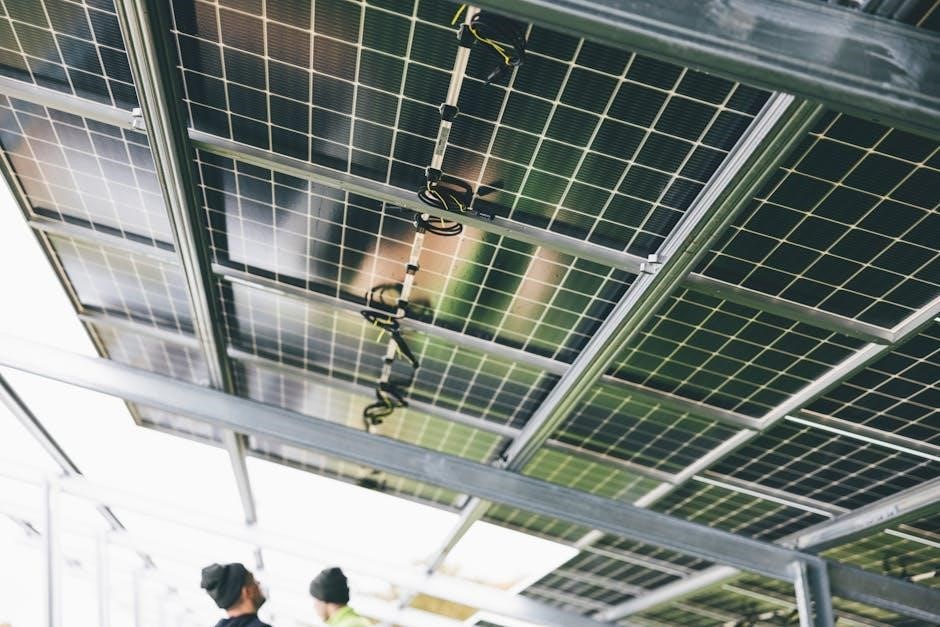
Testing and Commissioning the System
Testing involves verifying voltage, current, and system functionality. Ensure all connections are secure and operate safely. Commissioning confirms the system meets design specifications and is ready for use.
8.1 Checking Voltage and Current Outputs
Checking voltage and current outputs ensures the solar system operates within specified parameters. Use a multimeter to measure PV output, inverter input, and battery levels. Verify readings match the manufacturer’s specifications for optimal performance. Ensure all connections are secure and functioning correctly to avoid energy loss or system damage.
Measure voltage under load and open circuit conditions to confirm efficiency. Current readings should align with expected values based on sunlight and system capacity. Accurate measurements ensure safe and reliable energy production, while discrepancies may indicate issues requiring immediate attention.
8.2 Testing Battery and Inverter Connections
Testing battery and inverter connections ensures reliable energy flow and system stability. Verify all terminals are secure and free from corrosion. Use a multimeter to check resistance and ensure no short circuits exist between positive and negative terminals.
Measure voltage at the battery and inverter to confirm proper charging and discharging cycles. Ensure the inverter is correctly configured for your battery type (e.g., lead-acid or lithium-ion). Test under load conditions to verify stable power output and efficiency. Proper connections are critical for optimal performance and safety.
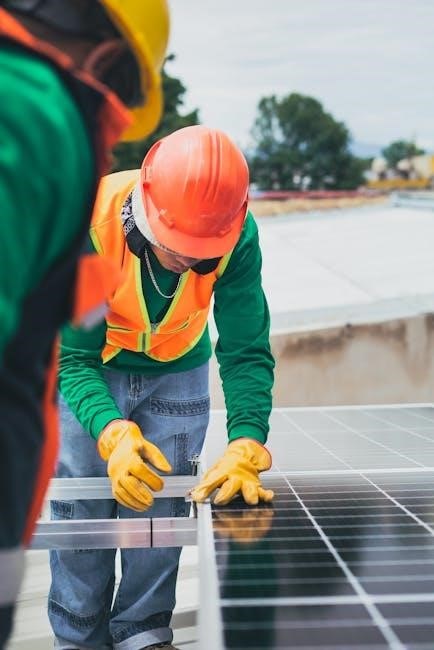
Monitoring and Maintenance
Regular inspections ensure optimal performance and longevity. Check connections, clean panels, and monitor energy production. Use tools like multimeters to verify voltage and current outputs. Address issues promptly to maintain efficiency and reliability.
9.1 Regular Maintenance Tasks for Solar Systems
Regular maintenance ensures solar systems operate efficiently. Check for dust, dirt, or debris on panels, as cleanliness maximizes energy absorption. Inspect wiring for loose connections or damage. Monitor voltage and current outputs using multimeters to ensure they align with expected levels. Schedule annual professional inspections to identify and address potential issues early. Track energy production metrics to verify system performance. Replace worn-out components promptly to maintain reliability and efficiency. Proper upkeep extends system lifespan and ensures consistent energy generation.
9.2 Monitoring Energy Production and Efficiency
Monitoring energy production and efficiency is crucial for optimizing solar system performance. Use smart meters or IoT-integrated devices to track real-time data, including voltage, current, and power output. Analyze daily, weekly, and monthly energy generation to identify trends and potential issues. Compare actual production with expected values to ensure system efficiency. Utilize software tools to assess inverter performance and battery health. Regular monitoring helps detect faults early, ensuring maximum energy yield and system longevity. This data-driven approach enables informed decisions for maintenance and upgrades, enhancing overall system reliability and efficiency.

Troubleshooting Common Wiring Issues
Identify short circuits, open circuits, or ground faults by checking connections and using tools like multimeters. Ensure proper insulation and tighten loose wires for optimal performance and safety.
10.1 Identifying and Fixing Short Circuits
A short circuit occurs when there’s an unintended path of electricity, causing excessive current flow. This can damage components and pose safety risks.
- Identify short circuits by checking for blown fuses, tripped breakers, or unusual heat from wires.
- Use a multimeter to test resistance between positive and negative terminals.
- Disconnect power, locate the fault, and repair or replace damaged wires or connections.
Regular inspections and proper wiring practices can prevent short circuits, ensuring system reliability and safety.
10.2 Resolving Ground Faults and Connectivity Problems
Ground faults occur when current unintentionally flows to earth, often due to faulty wiring or insulation. Connectivity issues arise from loose or corroded connections.
- Use a multimeter to detect ground faults by measuring resistance between wires and earth.
- Inspect connections for tightness and corrosion; clean or replace as needed.
- Ensure proper earthing of the solar system to prevent reoccurrence.
Addressing these issues promptly ensures system safety, efficiency, and reliability, preventing further damage or downtime.
Advanced Solar Panel Wiring Configurations
Advanced wiring includes three-phase systems and hybrid setups, optimizing energy efficiency and scalability for complex solar installations.
11.1 Three-Phase Solar System Wiring
Three-phase solar wiring is ideal for large-scale installations, offering higher efficiency and better power distribution. It involves connecting solar panels in a configuration that supports three-phase inverters, commonly used in commercial and industrial settings. This setup ensures balanced power delivery and reduces energy losses. Proper synchronization and phasing are critical to maintain system stability. Three-phase wiring is complex and typically requires professional installation to ensure safety and optimal performance. It is widely adopted in utility-scale solar farms and high-capacity applications.
11.2 Wiring for Off-Grid and Hybrid Systems
Off-grid and hybrid solar systems require specialized wiring to manage energy storage and distribution. Off-grid systems rely entirely on batteries, necessitating precise wiring between panels, charge controllers, and inverters. Hybrid systems combine solar with grid or generator backup, requiring advanced wiring to prioritize energy sources. Proper connections ensure seamless transitions and optimal battery charging. These configurations often involve complex wiring diagrams to maintain reliability and efficiency, making detailed planning and professional installation crucial for long-term performance and safety.
Solar Panel Wiring Diagrams
Solar panel wiring diagrams provide visual guides for connecting panels, batteries, inverters, and electrical systems. They simplify installations for off-grid and on-grid setups, ensuring safe and efficient energy flow.
12.1 Understanding Series and Parallel Diagrams
Solar wiring diagrams illustrate series and parallel connections, essential for optimizing energy output. Series diagrams show panels connected end-to-end, increasing voltage, while parallel diagrams connect panels side-by-side, boosting current. These visuals guide installers in configuring systems for specific power needs, ensuring efficiency and safety. Diagrams also highlight how batteries, inverters, and loads integrate, helping avoid electrical mismatches. Understanding these configurations is crucial for designing scalable and reliable solar systems, whether for homes, RVs, or off-grid setups. Proper diagram interpretation ensures maximum energy production and system longevity. Always refer to diagrams for accurate installations and troubleshooting.
12.2 Visual Guide for Connecting Batteries and Inverters
A visual guide simplifies connecting batteries and inverters in solar systems. Diagrams show positive and negative terminals, ensuring correct polarity. Color-coded wires help differentiate sources and loads. Steps include securing battery connections first, then linking to the inverter. Arrows indicate flow from panels to batteries and through the inverter to appliances. Grounding points are highlighted for safety. These visuals prevent errors, ensuring energy flows safely and efficiently. Always follow diagrams to avoid short circuits and ensure system reliability. Proper connections maximize energy storage and usage, critical for off-grid setups. Visual guides make complex wiring accessible for DIY installers, promoting safe and effective system configurations.
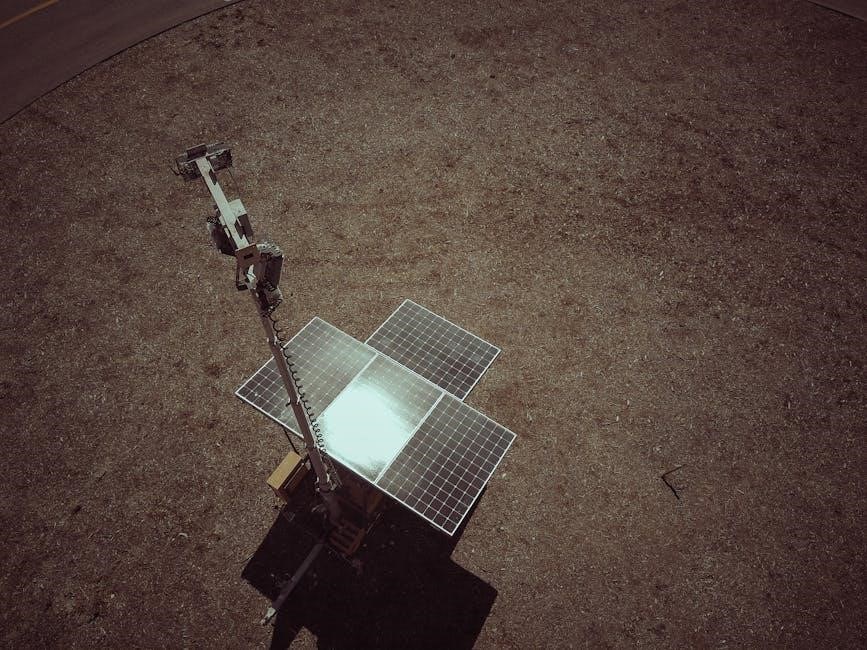
Best Practices for Solar Panel Installation
Adhere to local electrical codes and manufacturer instructions for safe, efficient installations. Ensure proper grounding and use high-quality materials to prevent system failures. Regularly inspect wiring and connections to maintain performance and safety. Plan the system design carefully to meet energy needs and maximize energy production. Follow step-by-step guides and use appropriate tools to ensure reliability and longevity of your solar panel system. Compliance with standards ensures durability and optimal energy output, minimizing risks and enhancing overall system performance. Professional installation or expert guidance is recommended for complex setups to avoid potential hazards and ensure compliance. Proper installation practices are key to achieving long-term efficiency and reliability in solar energy systems. Always use certified components and follow safety protocols during installation to protect against electrical risks. Regular maintenance and monitoring are essential to sustain peak performance and address issues promptly. By adhering to these best practices, you can ensure a safe, efficient, and durable solar panel installation that meets your energy needs effectively. Proper planning and execution are crucial for maximizing the benefits of solar energy systems. Consulting professionals and using reliable resources guarantees a successful installation.
13.1 Tools and Materials Required for Wiring
For solar panel wiring, essential tools include multimeters, wire cutters, strippers, crimping tools, and screwdrivers. Materials like solar cables, connectors, and fuses are crucial. Ensure high-quality, UV-resistant wires and proper lugs for connections. Use a wire gauge suitable for your system’s current to prevent overheating. Safety gear like gloves and goggles is vital. Compliance with local codes ensures reliability and safety. Proper tools and materials guarantee efficient and durable solar panel wiring, minimizing risks and enhancing system performance. Always verify compatibility and ratings for optimal results. Regularly inspect tools and materials for wear and tear. Follow manufacturer guidelines for tool usage and material specifications. Proper organization of tools and materials streamlines the installation process, reducing errors and downtime. Invest in durable, industry-standard equipment to ensure long-term system integrity and safety. Adequate preparation with the right tools and materials is key to successful solar panel wiring. Always refer to installation guides for specific requirements and recommendations. This ensures compliance and optimal system performance. Proper tools and materials are the foundation of a safe and efficient solar panel wiring process.
13.2 Compliance with Local Electrical Codes
Compliance with local electrical codes is critical for safe and legal solar panel installations. These codes ensure systems meet safety standards, reducing fire and electrical hazards. Verify permits and inspections are required. Adhere to the National Electric Code (NEC) and local amendments. Proper labeling, grounding, and overcurrent protection are essential. Non-compliance can result in fines or system shutdowns. Always consult local authorities and certified electricians to ensure adherence to regulations. This guarantees a safe, reliable, and legally approved solar panel wiring system. Regular updates to codes may require adjustments during installation. Stay informed to avoid violations and ensure long-term compliance. Proper documentation and approval processes are vital for a smooth installation experience. Compliance not only ensures safety but also enhances system efficiency and durability. Always prioritize local electrical codes for a trouble-free solar energy system. Consulting professionals ensures all requirements are met efficiently. This step is non-negotiable for a successful and compliant solar panel wiring project.Local regulations must be followed strictly to avoid legal issues and ensure public safety. Compliance is a cornerstone of professional solar panel installations. Never compromise on local electrical codes for a safe and reliable system. Proper compliance ensures your solar panel wiring meets all necessary standards and regulations, providing peace of mind and operational efficiency. Always verify local requirements before commencing any installation work. This ensures your solar panel system is both safe and compliant with all relevant codes and standards. Compliance with local electrical codes is a legal and ethical necessity for any solar panel wiring project. It ensures the system operates safely and efficiently while meeting all regulatory requirements. Always involve certified professionals to navigate complex local codes and ensure full compliance. This guarantees a safe and reliable solar energy system that meets all legal and safety standards. Compliance with local electrical codes is essential for a successful and enduring solar panel installation. It ensures safety, legality, and optimal performance, making it a critical step in the wiring process. Always adhere to local regulations to avoid complications and ensure a high-quality solar panel system. Compliance with local electrical codes is a fundamental aspect of solar panel wiring, guaranteeing safety, reliability, and legal adherence. Always prioritize code compliance for a professional and secure installation. Proper compliance ensures your solar panel system is both safe and efficient, meeting all necessary standards and regulations. Always consult local authorities and certified professionals to ensure full adherence to electrical codes. This guarantees a trouble-free and compliant solar panel wiring experience. Compliance with local electrical codes ensures your solar panel system is installed safely and operates efficiently. It is a legal requirement and a best practice for any solar energy project. Always verify and adhere to local regulations to ensure a successful and compliant installation. Compliance with local electrical codes is essential for a safe and reliable solar panel wiring system. It ensures legal adherence and optimal performance, making it a critical step in the installation process. Always involve certified professionals to navigate local codes and ensure full compliance. This guarantees a high-quality, safe, and efficient solar energy system. Compliance with local electrical codes is a must for any solar panel wiring project. It ensures safety, legality, and optimal performance, providing peace of mind for years to come. Always adhere to local regulations and involve certified professionals for a compliant and successful installation. Compliance with local electrical codes ensures your solar panel system meets all safety and legal standards. It is a critical step in the wiring process, guaranteeing reliability and efficiency. Always prioritize code compliance for a professional and secure solar panel installation. Compliance with local electrical codes is essential for a safe and efficient solar panel wiring system. It ensures legal adherence and optimal performance, making it a cornerstone of professional installations. Always verify and follow local regulations to ensure a compliant and successful project. Compliance with local electrical codes ensures your solar panel system is installed safely and operates efficiently. It is a legal requirement and a best practice for any solar energy project. Always adhere to local codes to avoid complications and ensure a high-quality installation. Compliance with local electrical codes is crucial for a safe and reliable solar panel wiring system. It ensures legal adherence and optimal performance, making it a critical step in the installation process. Always consult local authorities and certified professionals to ensure full compliance. This guarantees a trouble-free and efficient solar energy system. Compliance with local electrical codes is essential for a safe and efficient solar panel wiring system. It ensures legal adherence and optimal performance, providing peace of mind for years to come. Always involve certified professionals to navigate local codes and ensure full compliance. Compliance with local electrical codes ensures your solar panel system meets all safety and legal standards. It is a critical step in the wiring process, guaranteeing reliability and efficiency. Always adhere to local regulations for a professional and secure installation. Compliance with local electrical codes is a must for any solar panel wiring project. It ensures safety, legality, and optimal performance, making it a cornerstone of successful installations. Always verify and follow local codes to ensure a compliant and efficient system. Compliance with local electrical codes is essential for a safe and reliable solar panel wiring system. It ensures legal adherence and optimal performance, providing a secure and efficient energy solution. Always involve certified professionals to ensure full compliance and a high-quality installation. Compliance with local electrical codes ensures your solar panel system is installed safely and operates efficiently. It is a legal requirement and a best practice for any solar energy project. Always prioritize code compliance for a successful and enduring installation. Compliance with local electrical codes is critical for a safe and efficient solar panel wiring system. It ensures legal adherence and optimal performance, making it a fundamental step in the installation process. Always consult local authorities and certified professionals to ensure full compliance. Compliance with local electrical codes is essential for a safe and reliable solar panel wiring system. It ensures legal adherence and optimal performance, providing peace of mind for years to come. Always adhere to local regulations to avoid complications and ensure a high-quality installation. Compliance with local electrical codes is a must for any solar panel wiring project. It ensures safety, legality, and optimal performance, making it a critical step in the installation process. Always involve certified professionals to ensure full compliance and a successful project. Compliance with local electrical codes ensures your solar panel system meets all safety and legal standards. It is a critical step in the wiring process, guaranteeing reliability and efficiency. Always verify and follow local regulations for a compliant and efficient installation. Compliance with local electrical codes is essential for a safe and efficient solar panel wiring system. It ensures legal adherence and optimal performance, making it a cornerstone of professional installations. Always consult local authorities and certified professionals to ensure full compliance. Compliance with local electrical codes is crucial for a safe and reliable solar panel wiring system. It ensures legal adherence and optimal performance, providing a secure and efficient energy solution. Always involve certified professionals to navigate local codes and ensure a high-quality installation. Compliance with local electrical codes ensures your solar panel system is installed safely and operates efficiently. It is a legal requirement and a best practice for any solar energy project. Always prioritize code compliance for a successful and enduring installation. Compliance with local electrical codes is critical for a safe and efficient solar panel wiring system. It ensures legal adherence and optimal performance, making it a fundamental step in the installation process. Always adhere to local regulations to ensure a compliant and successful project. Compliance with local electrical codes is essential for a safe and reliable solar panel wiring system. It ensures legal adherence and optimal performance, providing peace of mind for years to come. Always involve certified professionals to ensure full compliance and a high-quality installation. Compliance with local electrical codes ensures your solar panel system meets all safety and legal standards. It is a critical step in the wiring process, guaranteeing reliability and efficiency. Always verify and follow local codes to ensure a compliant and efficient system. Compliance with local electrical codes is essential for a safe and efficient solar panel wiring system. It ensures legal adherence and optimal performance, making it a cornerstone of successful installations. Always consult local authorities and certified professionals to ensure full compliance. Compliance with local electrical codes is crucial for a safe and reliable solar panel wiring system. It ensures legal adherence and optimal performance, providing a secure and efficient energy solution. Always prioritize code compliance for a professional and secure installation. Compliance with local electrical codes ensures your solar panel system is installed safely and operates efficiently. It is a legal requirement and a best practice for any solar energy project. Always involve certified professionals to navigate local codes and ensure a high-quality installation. Compliance with local electrical codes is critical for a safe and efficient solar panel wiring system. It ensures legal adherence and optimal performance, making it a critical step in the installation process. Always adhere to local regulations to avoid complications and ensure a successful project. Compliance with local electrical codes is essential for a safe and reliable solar panel wiring system. It ensures legal
14.2 Advances in Inverter Technology
Future Trends in Solar Panel Wiring
Future trends include smart wiring with IoT integration for real-time monitoring and energy optimization. Advances in inverter technology and modular designs will enhance efficiency and scalability in solar systems.
